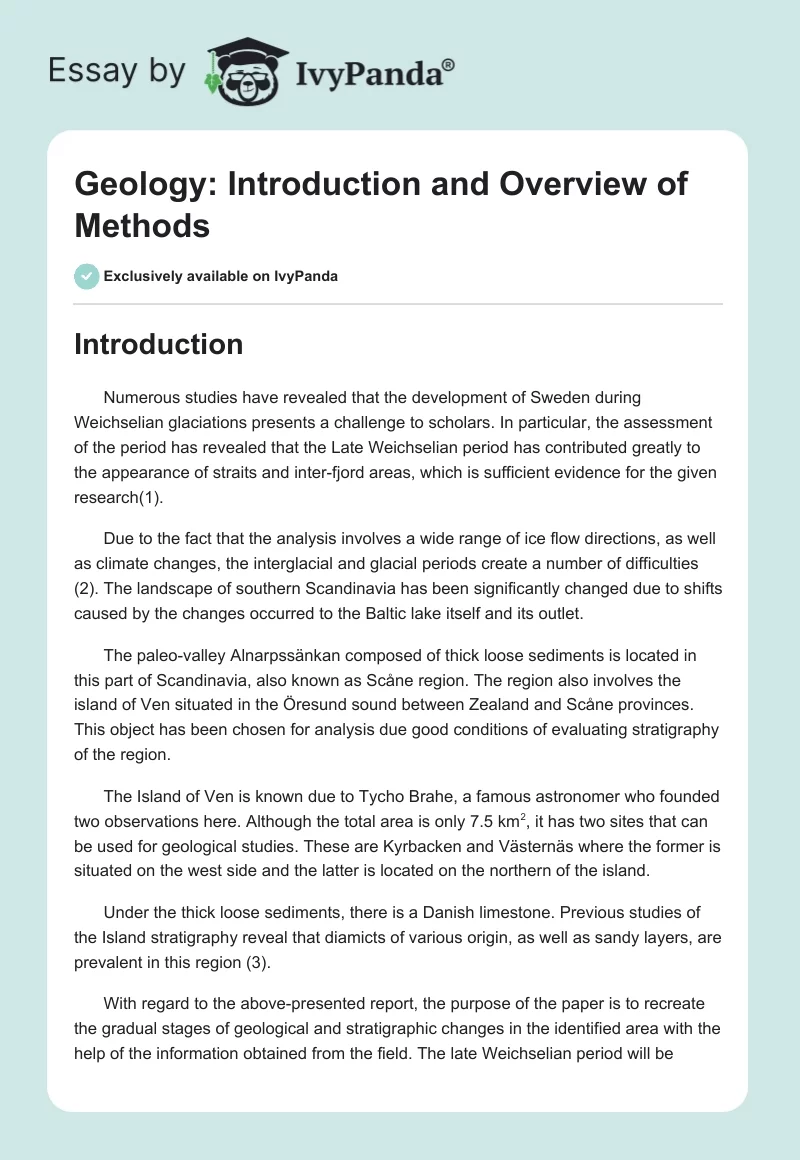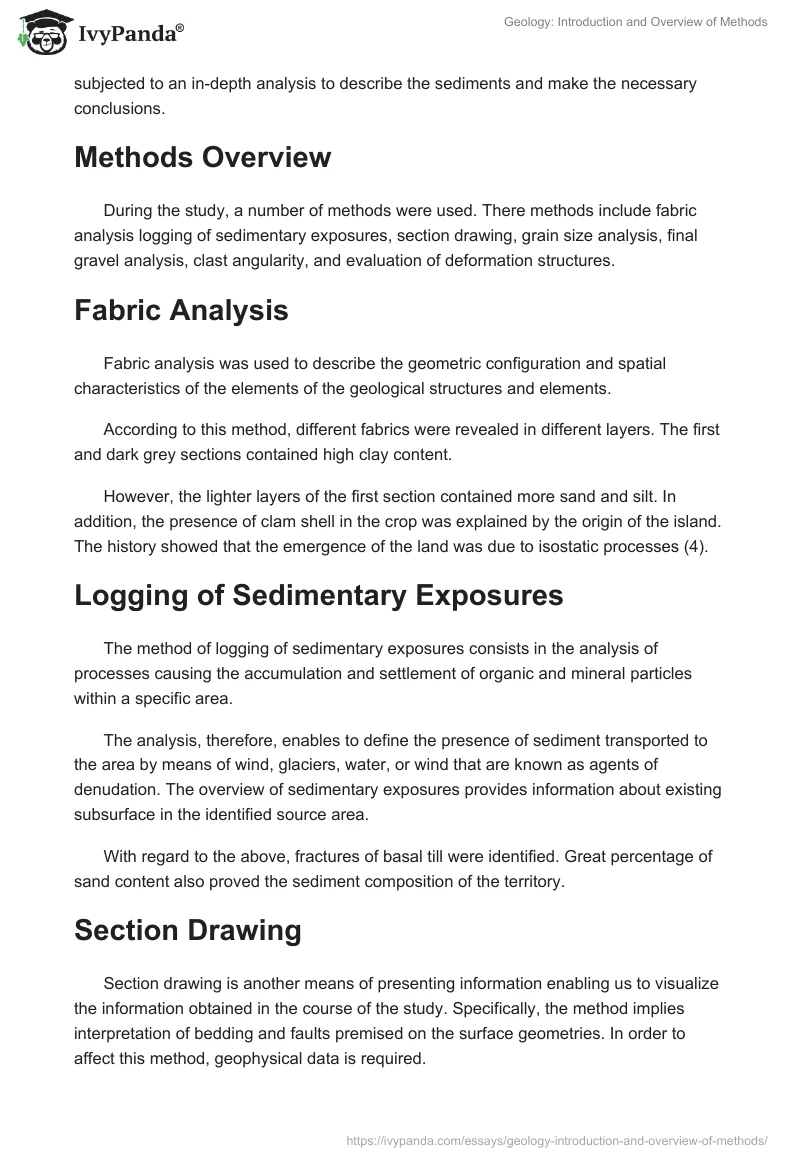Introduction
Numerous studies have revealed that the development of Sweden during Weichselian glaciations presents a challenge to scholars. In particular, the assessment of the period has revealed that the Late Weichselian period has contributed greatly to the appearance of straits and inter-fjord areas, which is sufficient evidence for the given research(1).
Due to the fact that the analysis involves a wide range of ice flow directions, as well as climate changes, the interglacial and glacial periods create a number of difficulties (2). The landscape of southern Scandinavia has been significantly changed due to shifts caused by the changes occurred to the Baltic lake itself and its outlet.
The paleo-valley Alnarpssänkan composed of thick loose sediments is located in this part of Scandinavia, also known as Scåne region. The region also involves the island of Ven situated in the Öresund sound between Zealand and Scåne provinces. This object has been chosen for analysis due good conditions of evaluating stratigraphy of the region.
The Island of Ven is known due to Tycho Brahe, a famous astronomer who founded two observations here. Although the total area is only 7.5 km2, it has two sites that can be used for geological studies. These are Kyrbacken and Västernäs where the former is situated on the west side and the latter is located on the northern of the island.
Under the thick loose sediments, there is a Danish limestone. Previous studies of the Island stratigraphy reveal that diamicts of various origin, as well as sandy layers, are prevalent in this region (3).
With regard to the above-presented report, the purpose of the paper is to recreate the gradual stages of geological and stratigraphic changes in the identified area with the help of the information obtained from the field. The late Weichselian period will be subjected to an in-depth analysis to describe the sediments and make the necessary conclusions.
Methods Overview
During the study, a number of methods were used. There methods include fabric analysis logging of sedimentary exposures, section drawing, grain size analysis, final gravel analysis, clast angularity, and evaluation of deformation structures.
Fabric Analysis
Fabric analysis was used to describe the geometric configuration and spatial characteristics of the elements of the geological structures and elements.
According to this method, different fabrics were revealed in different layers. The first and dark grey sections contained high clay content.
However, the lighter layers of the first section contained more sand and silt. In addition, the presence of clam shell in the crop was explained by the origin of the island. The history showed that the emergence of the land was due to isostatic processes (4).
Logging of Sedimentary Exposures
The method of logging of sedimentary exposures consists in the analysis of processes causing the accumulation and settlement of organic and mineral particles within a specific area.
The analysis, therefore, enables to define the presence of sediment transported to the area by means of wind, glaciers, water, or wind that are known as agents of denudation. The overview of sedimentary exposures provides information about existing subsurface in the identified source area.
With regard to the above, fractures of basal till were identified. Great percentage of sand content also proved the sediment composition of the territory.
Section Drawing
Section drawing is another means of presenting information enabling us to visualize the information obtained in the course of the study. Specifically, the method implies interpretation of bedding and faults premised on the surface geometries. In order to affect this method, geophysical data is required.
The information can also be achieved through the geometric analysis. The analysis of isostatic equilibrium also plays a pivotal role in evaluating the stratigraphic information, including surface features. With regard to the above-described method, the studies were also based on the information received from GPS coordinates.
Grain Size Analysis
The method of grain size analysis (distribution) allows to define the hydraulic conductivity of the soils and rocks presented in the identified sites. For instance, water-saturated particles are typical of finer grains. Gravels and sands possessing a variety of particles with a smooth distribution are well graded. In general, the grain size distribution allows to define the frequency of shifts occurred to the identified sites (5).
Grain size revealed acceptable norms. The grains were mostly rich in silt. They prevailed in the lighter sections of the rock. These processes were caused by the emergence of agents of denudation.
Fine Gravel Analysis
Fine gravel analysis is identified as an important stratigraphic tool in the geological and quaternary research. Specifically, it has contributed greatly to studying deposits and explaining the changes caused by early glaciations in the identified area (6).
In order to present a complete fine gravel analysis of the identified sites, particular reference should be made to the studies of the late Weichselian period because it had a potent impart of the formation of the structures and sediments in the region.
During the study, six important layers were defined. The first layer was relatively compact; lamination was identified in the second layer of the rock. The third layer was marked by the presence of small structures that were very massive.
The analysis of fourth layers revealed finer, but a bit coarser sand lenses. Further, about 130 streamlines were discovered. The following layers contained colored silt and deformed ripples. In general, it should be stressed that the entirely laminated area amounted to 286 cm whereas highly laminated section was about 1 meter.
Clast roundness
The analysis of clastic rocks also plays a crucial role in defining the influence of the glaciations on the identified area. Depending on the degree of abrasion, it is possible to define the time and distance involved in logging of sedimentary exposures from the original area to the deposited one.
The speed of angularity also signifies hardness and composition of cleavage. Hence, the presence of clay implies greater speed of rounding, as well as shorter distance of transporting (7). The energy conditions also contribute to the identification of angularity degree.
Deformation Structures
Deformation structures analysis can be carried out though the evaluation of sediment composition, including hardness of mineral and particles. The method allows to identify the speed and degree of deformations occurred to the source area with regard to the presented fabric rocks. In general, the method is useful for identifying the nature of deeper layers and their characteristics.
The analysis of deformation structures revealed that that many minerals and rock were of soft-sediment nature, including such components as silt, clay, and sand. Judging from the results of the studies, it can be stated that the structures referred to convolute bedding and slump structures.
Reference List
- Alexanderson, A, Landvik, JY, & Ryen, HT,‘Chronology and styles of glaciations in an inter-fjord setting, northwestern Svalbard’, An International Journal of Quaternary Research, vol. 40, 2010, pp. 175-197.
- Houlmark-Nielsen, M, and Henrik Kjerk, K, ‘Southwest Scandinavia, 40-15 kyr. BP: palaeogeography and environmental change’, Journal of Quaternary Science, vol. 18, no. 8, 2003, pp. 769-786.
- Kjaer, KH, Demidov, IN, Larsen,E, Murray, A, and Nielsen, JK, ‘Mezen Bay – a key area for understanding Weichselian glaciations in northern Russia’. Journal of Quaternary Science, vol. 18, 2006 no. 1, pp. 73-93.
- Lysa, A, M. Jensen, MA, Larsen,E, Fredin, O and Demidov, IN, ‘Ice-distal landscape and sediment signatures evidencing damming and drainage of large pro-glacial lakes, northwest Russia’, vol. 40, 2009, pp. 481-487.
- Larsen, NK, Knudsen,KL, Krohn, CF, Kronbord, C, Murray, AC, & Nielsen OB, ‘Late quaternary ice sheet, lake and sea history of southwest scandinavia – a synthesis’, An International Journal of Quaternary Research. vol. 38, 2009, pp. 732-761.
- Kjaer, KH, Lagerlund, E, Adrielsson, L, Thomas, PJ, Murray, A, and Sandgren, P, ‘The first independent chonology of Middle and Late Weichselian sediments from southern Sweden and the island of Bornholm’, GFF, vol. 128, 2006, pp. 209-220.
- Linden, M, and Moller, P, ‘Marginal formation of De Geer moraines and their implications to the dynamics of grounding line recession’. Journal of Quaternary Sciences, vol. 20, no. 2, 2005, pp. 113-133.


